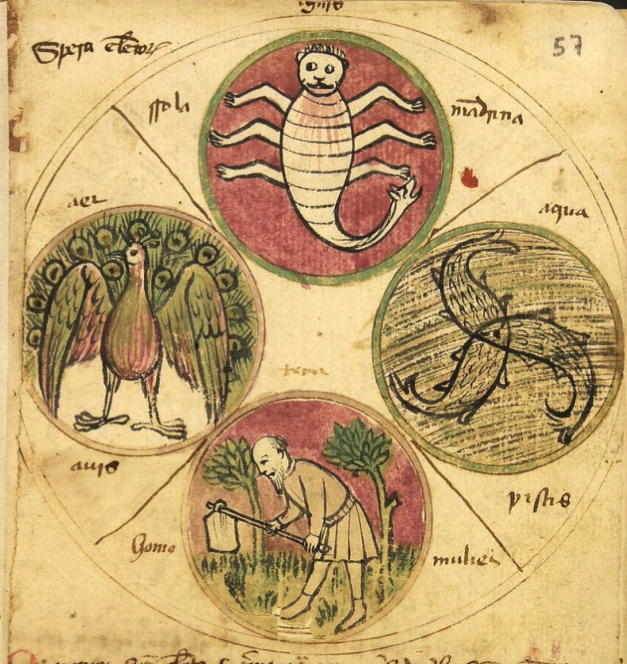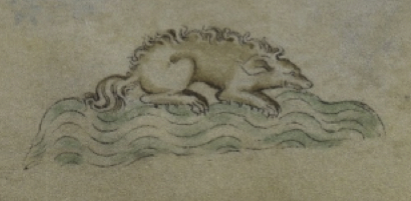where can i purchase Pregabalin Wilderness land was far more abundant in the Middle Ages than it is now. If you moved 80% of humans to another planet (along with their houses, roads, schools, and offices) and then spread the remaining 20% over the entire globe, that is how the planet was populated in the year 1400.
http://neilfeather.com/wp-json/oembed/1.0/embed?url=http://neilfeather.com/instruments-available-for-sale/ There was much more undeveloped land and contact with animals in those days. Most people lived on or near farms. Milk came from a cow or goat, not from a supermarket. Pigs and pigeons were purchased in the marketplace and slaughtered right there in the stall or in the back yard at home. A “taxi” was a horse, donkey, or ox-cart. Animals were everywhere—a king with bow and arrow could shoot hundreds in a single day without straying far from the castle.
And yet medieval illustrations of animals are weird—cows look like horses, ants look like bears, and reptiles/amphibians look like dinosaurs.
There are a number of possible explanations for this…
- There were no television sets, Internet, or public libraries displaying images of animals from outside the person’s local area, and illustrated books were scarce (they were luxury items tucked away in monastic and private institutions). It’s hard to draw something you have never seen and even a good verbal description is sometimes not enough.
- The medieval person’s sense of reality was different from ours. There were no public schools and the populace was mostly illiterate. Education was based on traditional folklore rather than scientific observation. If people were told the sun revolved around the earth, they believed it, and if they didn’t believe it, they risked death or imprisonment because conformity was strongly enforced.
- There were religious taboos against drawing certain things in certain ways. To avoid idolatry, humans were often drawn as hybrids, and legends about an animal often influenced how it was drawn more than physical reality. Sometimes a drawing was thought to contain the spirit of what was drawn.
- Some mythical creatures were believed to be real.
- Some illustrators and scribes worked in scriptoria where division of labor, or the presence of servants, separated them from daily tasks such as catching and slaughtering animals. Their concept of animals came from copying other texts, not from first-hand experience. Even if they knew a better way to draw something, tradition often demanded conformity to earlier exemplars.
But enough background… let’s look at some pictures. Here are some medieval critters that might make you smile. The first one is the leucrota:
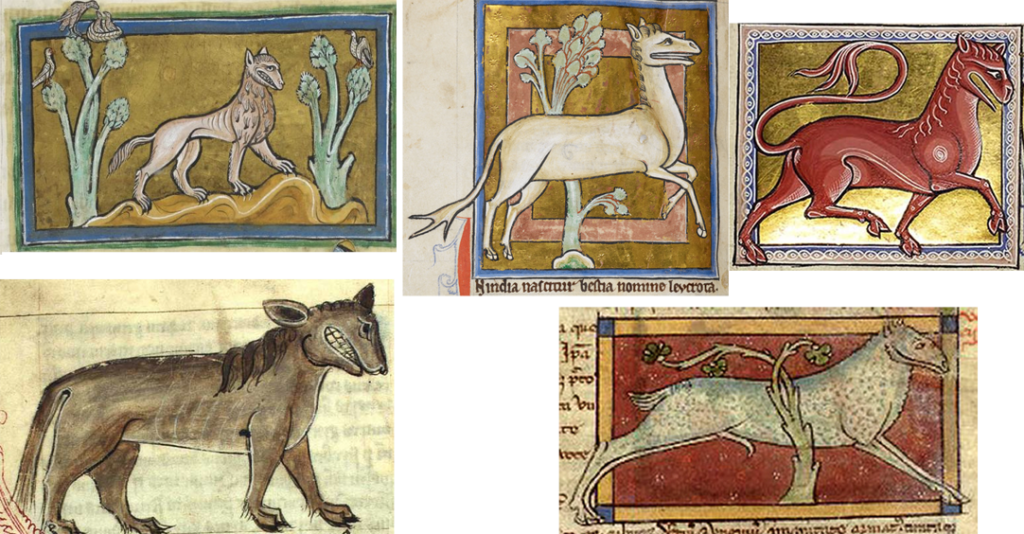
Leucrota images courtesy of the Kongelige Bibliotek (lower left), Bibliothèque Nationale de France (lower right), and the British Library.
The leucrota was believed to be a cross between a lion and a crocotta (a “dog-wolf”), with hind-quarters like a deer. The drawing top-left somewhat conveys this idea, it has claws and a more lion-like mane, but the drawings top-right scarcely resemble the offspring of a dog-wolf and lion—they have the head of a horse and the feet of a deer, and the bottom one looks like a cross between a sheep and a deer. The leucrota in Ms Bodley 533 doesn’t even resemble the images above, it looks like an angry sheep.
The only feature the various leucrota have in common is the distinctive long grin.
The leucrota isn’t necessarily mythical. It is sometimes described as a cross between a lion and a hyena, which may originally have been an attempt to describe a different species of hyena. The brown hyena (right) is quite a bit larger and furrier than the more familiar spotted hyena:
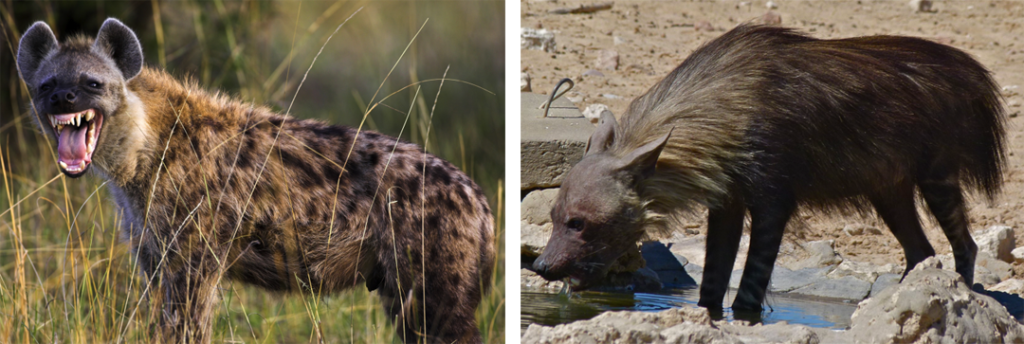
Left; Spotted hyena with mane, stubby tail, and fearsome grin, courtesy of PBS.org Animal Guide. Right: Brown hyena, which is quite a bit larger than other hyenas, and may have inspired descriptions of the “leucrota” (described as a cross between a lion and a wolf-dog (hyena). Image courtesy of Bernard Dupont on Wikipedia.).
If you look at the individual features of the leucrota in medieval drawings, the features seem a little less strange—the hyena is a doglike animal with a mane like a horse, the aggressive temperament of a lion, a moderately short tail used for signaling (like a deer), long legs with hoof-like paws, and a ferocious toothy jaw. In a way, medieval drawings are descriptive of individual parts even if the overall composition goes slightly awry.
Note that the drawing of a hyena in the manuscript below-left is more realistic. The illustrators of Arabic manuscripts lived closer to hyenas than those in central and northern Europe and were more likely to have seen them. Northerners tended to stylize or completely fictionalize the animal.
Using Props to Tell the Story
The hyena is both predator and scavenger. Its scavenging instincts were often expressed by drawing the animal stealing a corpse (bottom-right). Once the meme of the corpse-stealer became familiar, the illustrator could take liberties with the way the animal was drawn. Visual memes and attributes served as visual memory aids:
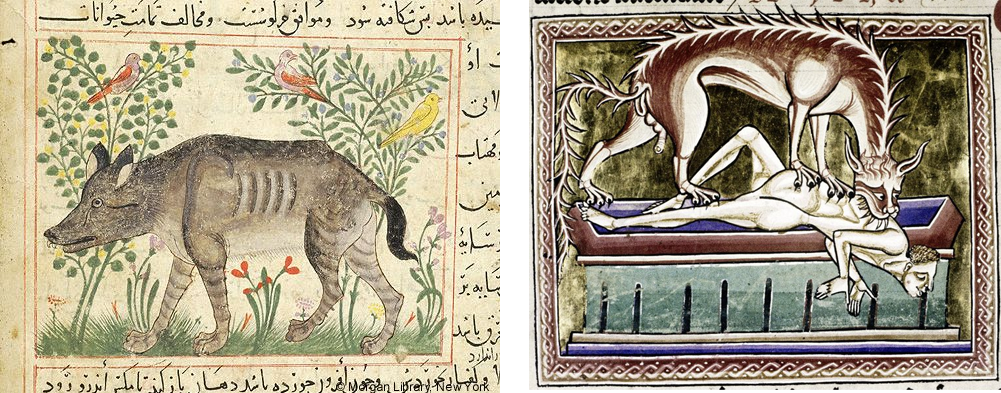
Left: a more naturalistic rendition of the hyena in an Arabic manuscript. Right: A stylized version of a hyena-monster desecrating a grave and stealing a corpse, a reference to the hyena’s scavenging habits.
In a previous blog about castorum, I included drawings of beavers that are quite fanciful, and here is one of my favorite drawings… ants that look like dogs and bears, from Cotton Vitellius A XV:
It’s a Croc
Equally strange are medieval drawings of crocodiles.
The smile of the crocodile is similar to the hyena’s toothy grin, but that’s where the resemblance ends. The medieval crocodile is sometimes drawn like a fish, sometimes like a lion, giant dog, monkey, or furry hedgehog, and sometimes like a basilisk, dragon, or dinosaur. There are even some that look like leucrotas.
The only way we know for sure it’s a crocodile is because it says so in the text, in combination with familiar legends, such as the crocodile eating a man (and crying crocodile tears after doing so), and the crocodile being outfoxed by the hydra.
There are several medieval crocodiles that look like monkeys, and one of them is slightly more reptilian than the others, but even it has a primate face rather than a reptile face. There is also one that looks more like a human-faced lion than any kind of reptile:
The crocodile carving on the wall of Chichester Cathedral (c. 1330) looks like a big fat beagle with a somewhat human face. You would never guess it was a crocodile.
There are many crocodiles drawn like mammals, I couldn’t fit them all, but the examples above should be enough to get the idea across—you can’t tell what they are just by looking at them.
What about lizards and salamanders?
Voynich researchers are probably wondering how lizards and amphibians are drawn because the VMS Scorpius looks more like a reptile/amphibian than an arthropod.
Sloane 4016 is a well-known herbal manuscript that includes a brontosaurus-like salamander standing on fat, upright legs (rather than splayed legs), labeled “salamandra”:
Here’s an even more extreme example from Montpellier H 437:
The giant dog-kangaroo in H 437 is labeled “salamandre” (salamander) and has the “fire salamander” flames to confirm that the text and image are in synch with one another.The following illustration of the elements in Biblioteca de Catalunya. Ms. 1452 (based on Ramon Lull’s 13th-century astronomy/astrology) makes this association between fire and salamanders even more explicit. In this diagram, earth is represented by a man working the soil, water is a trio of fish, air is a peacock (which ironically can’t fly very well and rarely takes to the air), and fire is a salamander that looks more like a scorpion than an amphibian with the deeply curved tail and extra legs, but is clearly labeled “mandrina” which is short for “salamandrina”—an amphibian:
Crocodiles and lizards are reptiles and the drawing of Scorpius in the VMS and a number of other manuscripts that include zodiac symbols are drawn as reptiles/amphibians, dragons, turtles, and frogs. Here is version 1.1 of a map I created of the zodiac symbols that most closely resemble the reptilian creature in the VMS (originally posted on my 2016 blog about Scorpius symbols):
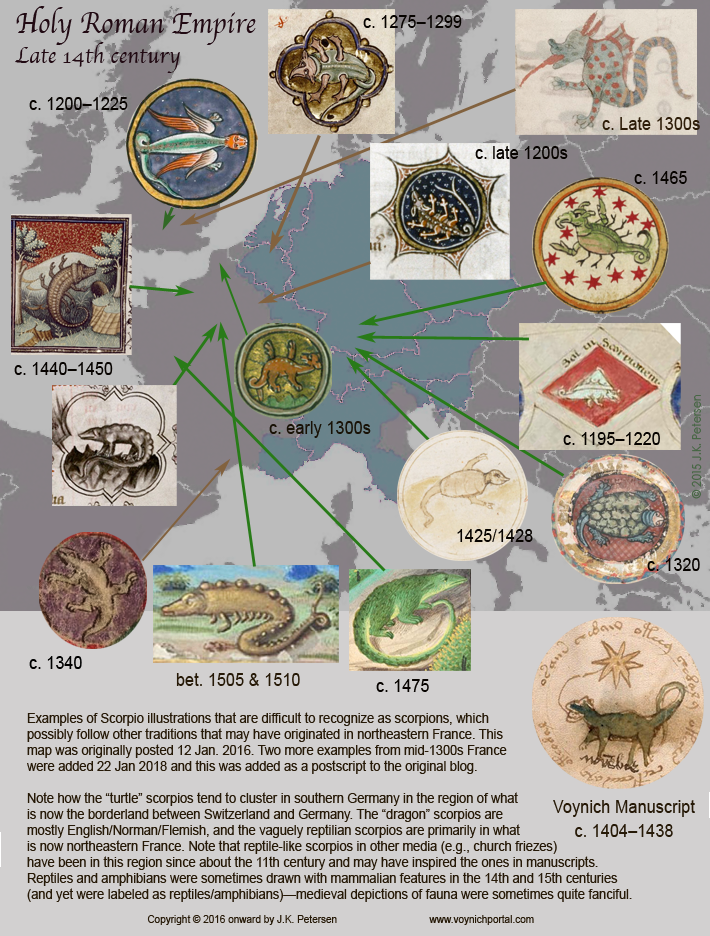 As can be seen by these examples, Scorpius symbols of a vaguely repitilian/amphibian character with upright legs occur in European manuscripts in the 14th, 15th, and 16th centuries, especially in France. I did locate one more lizard-like creature from the 16th century, and an earlier example of Scorpius-as-serpent, but opted to leave them out of the map.
As can be seen by these examples, Scorpius symbols of a vaguely repitilian/amphibian character with upright legs occur in European manuscripts in the 14th, 15th, and 16th centuries, especially in France. I did locate one more lizard-like creature from the 16th century, and an earlier example of Scorpius-as-serpent, but opted to leave them out of the map.
Can We Tell Them Apart?
The medieval lizard-like Scorpius can usually be distinguished from medieval crocodiles by thinner legs, overall smaller size, and a milder expression on the face (crocodiles are frequently shown biting a human or a hydra). It’s not a big difference, but clearly none of the zodiac-Scorpios look like kangaroos, boars, monkeys, dogs, or lions.
As can be seen from the map, turtle-Scorpios tend to be from southern Germany and the Alsace, dragon-Scorpios from England/Normandy, and the zodiac symbol that most closely matches the VMS Scorpius in general proportions and uprightness of the legs is from Paris, France.
It seems very likely that the VMS zodiac illustrator had seen Parisian manuscripts or had visited churches with zodiac friezes in the north-east of France, where lizard-like Scorpios were cast into stone as early as the 11th century.
J.K. Petersen
Copyright © 2018 J.K. Petersen
_________________________________________
Postscript 7 June 2019 [addition]: I found this drawing in an early 14th-century English manuscript and felt it was appropriate to add to this blog.
It has long ears, a long nose, a ridge of wavy fur along its back, and a fluffy tail. Can you guess what it is?
British Library MS Royal 2 B VII (a crocodile).

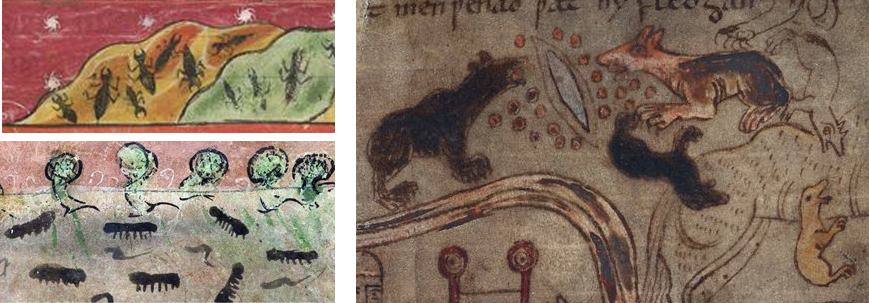
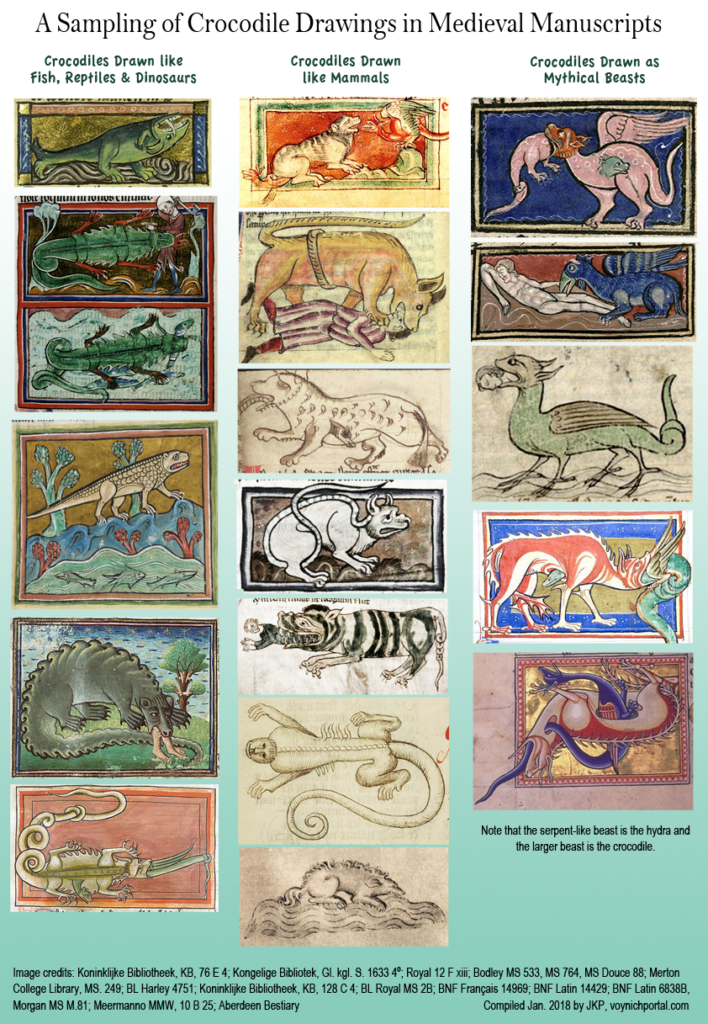
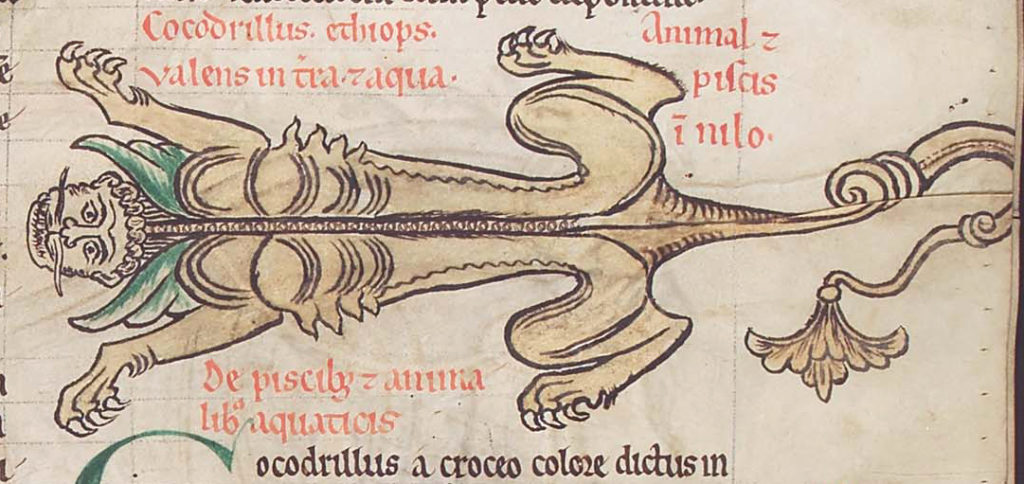
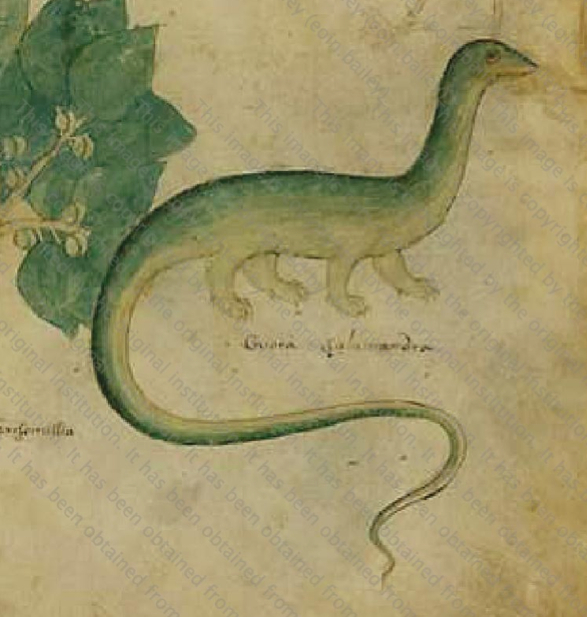
![[Image of medieval salamander that resembles a kangaroo]](https://voynichportal.com/wp-content/uploads/2018/01/SalamanderH437-1024x460.png)
